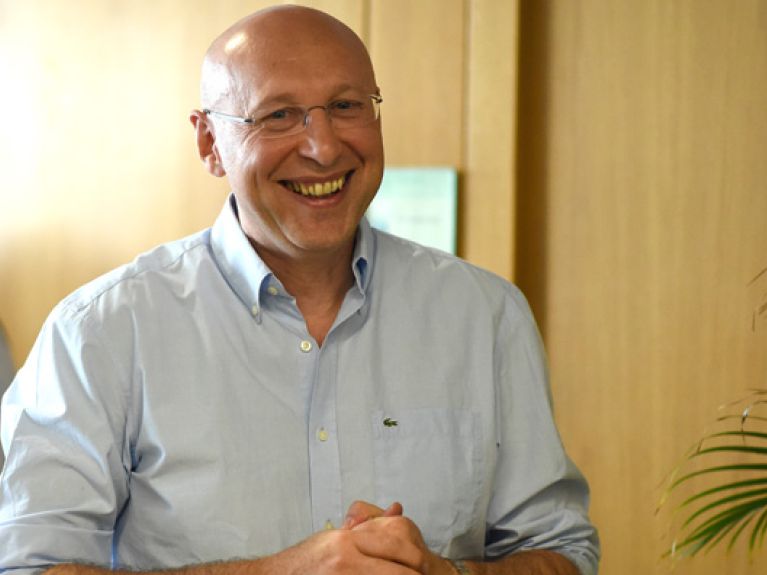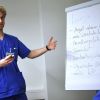Laboratories for the brightest minds
A passion for undiscovered worlds: whether they are investigating plants, virtual reality, the ocean depths or outer space, leading researchers in Germany are taking us beyond the boundaries of our current knowledge.

For more than 120 years, one limit seemed unbreachable: the degree of resolution offered by light microscopes. In 1873, the physicist Ernst Abbe postulated that it is impossible to discern similar structures smaller than 200 nanometres. In other words, some things like nerve cells would never be seen precisely. One might call the desire to overcome such an accepted limit youthful exuberance – or megalomania. Or perhaps not. “I felt pretty sure that something more was possible,” says Professor Stefan Hell today. In truth, the physicist got round the problem by using a trick. Experimenting with lasers, he ingeniously made fluorescent molecules attached to cells glow – not at the same time, but one after the other. It was revolutionary and won him the 2014 Nobel Prize in Chemistry – the epitome of renown. Yet Hell knows his success also resulted from overcoming another type of limit: national borders. As a child he left Romania for Germany, and it was in Finland that he worked on his ideas for a stimulated emission depletion (STED) microscope. Yet Germany again became his base when he joined the Max Planck Institute for Biophysical Chemistry in Göttingen. He has been the institute’s director since 2002 and that is where he was able to bring his new microscope to market. He even turned down an offer from Harvard, working closely with the German Cancer Research Center in Heidelberg instead.
At 315 metres, the microscope Professor Henry Chapman uses to measure biological substances like proteins is gigantic. It is called a free-electron laser and can be found at DESY, the particle accelerator centre in Hamburg. “There is only one of these devices worldwide,” says the Briton, who studied in Australia, did research in the US and became founding director of the Center for Free-Electron Laser Science. “Germany is a wonderful place for research. Here you can make long-term plans. It is amazing how interested non-scientists are in our work.” Biomolecules are fragile, so Chapman develops complex experiment protocols that require an exact understanding of how lasers interact with proteins. In 2015 he received the Leibniz Prize, Germany’s leading research award, for his pioneering work, which also influences other fields.
Overcoming the boundaries between scientific fields is an everyday event for Professor Johann-Dietrich Wörner, an experienced research manager. As designated director general of the European Space Agency (ESA), he will become Europe’s “senior spaceman” in mid-2015. A trained civil engineer, Wörner was a professor of structural analysis at Technische Universität Darmstadt and then its president before becoming head of the German Aerospace Center (DLR) in 2007. Under the auspices of this Helmholtz institution, more than 8,000 specialists carry out research in the areas of aeronautics, astronautics, energy, transport and safety. “In Germany there are numerous research topics and institutes that are second to none,” he says. What excites him about his new position as ESA head in Paris is the chance to foster a pan-European mindset and to promote Europe’s space-exploration efforts. He will also be fulfilling a childhood dream, since even as a boy he was fascinated by outer space. He would send a spaceship to Mars without thinking twice, he says.
While humans are slowly, turning space into a new habitat, other species continue to do the same thing here on earth. One particularly successful example is the round goby. This generally unremarkable fish only grows to 20 centimetres in length and is usually found in the Black Sea. However, it has also made itself at home in the lakes of North America, where Elizabeta Briski has spent several years studying it. “The issues I want to examine connect Europe, Asia and America. That’s why I have decided to return to Europe,” says the native Croatian. Having been awarded the Sofja Kovalevskaja Award for junior researchers, Briski is assembling a team at the GEOMAR Helmholtz Centre for Ocean Research in Kiel. Since scientists have observed almost no migration of fish in the opposite direction – from North America to Asia – Briski is examining whether species from the Caspian Sea and Black Sea are better equipped genetically to conquer unknown habitats.
As a marine biologist, Professor Nicole Dubilier is also an expert for unusual habitats. And she reaches them using German research vessels such as Sonne, Maria S. Merian and Meteor. The ocean depths and sulphide-rich coastal sediments offer conditions just as challenging for living organisms as outer space. Originally from the US, Dubilier has been at the Max Planck Institute for Marine Microbiology in Bremen since 2001, where she researches how invertebrates like worms manage to survive in environments offering little energy or food. She has been the organisation’s director since 2013. “I always wanted to come to this institute, since it offers optimal working conditions,” she says. Her research has provided fascinating new insights into symbiotic life forms. For example, host organisms such as worms nourish themselves by cooperating closely with bacteria, which supply them with food by metabolising substances present in the otherwise hostile environment. It’s an example of teamwork, something “Nicole von Worm” – to quote the nameplate on her office door – very much appreciates in her field of research.
To a certain extent scarce resources are also what drive Jürgen Leohold, executive director of Group Research at Volkswagen. The electrical engineer spends his time dealing with topics such as electromobility, lightweight construction and driverless cars. “There is a lot to research. We have to address a number of topics,” he says. As the head of research he coordinates the work of 9,300 specialists. Volkswagen is a world leader in terms of its expenditures on R&D and maintains one of the automotive industry’s largest development facilities in its hometown of Wolfsburg. The experts at VW also cooperate with numerous universities and Fraunhofer Institutes.
The complementary worlds of science and business are something food technologist Stephanie Mittermaier knows all about. As departmental director at the Fraunhofer Institute for Process Engineering and Packaging in Munich, she deals with a topic that couldn’t be more hip: how lupins can be used as the basis for a vegan diet. “In contrast to soya, this plant, which is also rich in protein, is indigenous, easy to grow and hasn’t been genetically modified,” she says. Unfortunately, lupins have a grassy, bean-like taste. With her colleague Peter Eisner, Mittermaier has developed a process for removing the unpleasant flavours. The neutral-tasting proteins can be processed into milk, cheese, cake and sausage. In 2013, the first facility for producing Prolupin, a spin-off product, opened its doors. Today ice cream made from lupins is a popular item at organic food shops. And precisely that is what excites Mittermaier about research in Germany. “Here I have a lot of freedom and outstanding facilities to develop high-quality, innovative products that end up in supermarkets,” she says. In 2014, Mittermaier and her colleagues were awarded the Deutscher Zukunftspreis (German Future Prize). Among other things, the prize recognised that lupins could play a part in feeding the world’s constantly growing population in a resource-efficient manner.
Professor James Vaupel takes another view of the globe’s population – that of a statistician and demographer. Originally from the US, he has done a lot to reinvent demographic research. For example, he has observed that people are living longer since the aging process is beginning later – a hypothesis at odds with the idea that there is a maximum life expectancy. In 1996, Vaupel became founding director of the Max Planck Institute for Demographic Research in Rostock, which is now world renowned. Vaupel is convinced that biology alone will provide the answer to how long people can live. He will soon turn 70 and has clear ideas about his own future: he wants to keep researching, teaching and learning until he is 85.
Why do we lose some of our ability to learn when we become adults? How do we combine our abilities to see, hear and feel? To what extent can the brain compensate for blindness or deafness? Does the ability to compensate depend on a person’s age? Questions like these are driving research in the areas of education and rehabilitation medicine, as Brigitte Röder well knows. The professor of biological psychology and neuropsychology feels she has excellent conditions for carrying out her research at the University of Hamburg, not least because of her affiliation with the Hamburg Center of NeuroScience. “Our research is only possible as part of this interdisciplinary complex of psychology, medicine and IT,” she says. Having worked repeatedly in the US, she decided to do her research in Germany for a number of reasons, she says, including the country’s extensive efforts to promote research and its highly qualified younger generation of scientists.
Onur Güntürkün is also fascinated by the brain – and pigeons. “They are my scientific pets,” says the professor of biopsychology. He researches these amazingly intelligent, adaptive birds in his laboratories at the Ruhr-Universität Bochum. For example, he discovered that the brains of pigeons and other animals are asymmetrical, like the human brain, which handles spatial orientation mostly on the right side and language mostly on the left. That means the birds are excellent candidates for exploring how both sides of the brain work together. “Our thoughts arise in the brain as the result of the activity of billions of nerve cells. How this produces thought is the central question in my life,” Güntürkün says. While still in school in Turkey he was fascinated by psychology and went on to study in Germany and do research in France and the US before becoming a professor in Bochum – where he shares his enthusiasm for thinking with his own students.
Brains and pigeons could also be the protagonists in the worlds that Leif Kobbelt creates. The Leibniz Prize laureate and professor of computer graphics at RWTH Aachen University develops methods for generating three-dimensional models of complex objects. The IT expert is considered one of the world’s leading specialists for geometric processing and is a pioneer in point-based graphics. This new field is being used to precisely simulate complex machines, plan surgical operations or even entire cities, and design fantasy worlds for computer games that seem authentic. And that makes Kobbelt a master at overcoming boundaries – the ones separating virtual reality from real life.
www.humboldt-foundation.de/web/dossier-kovalevskaja-preis.html

